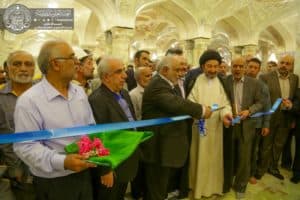
Former IRGC commander and alleged Qods Force officer Hassan Pelarak inaugurating the initial phases of project to expand the Hazrat Zahra shrine in Najaf, Iraq, September 20, 2016.
The head of the Islamic Revolutionary Guard Corps’ (IRGC) engineering arm announced at a meeting with Iran’s supreme leader on September 20 the inauguration of two phases of a massive project to expand a Shiite shrine in Najaf, Iraq.
Known as Khatam al Anbiya Construction Base (KAA), the IRGC’s giant conglomerate has partnered with the Headquarters for the Restoration of Holy Shrines (HRHS) for a project to develop and expand the shrine of Hazrat Zahra, which is part of the Imam Ali shrine complex. HRHS is a front for the Qods Force, the Guard’s extraterritorial operations branch, and has decade-long history in Iraq.
Designated by the US Treasury in 2010, KAA “helps the IRGC generate income and fund its operations,” and is involved in the construction of streets, highways, tunnels, water conveyance projects, agricultural restoration projects, refineries and pipelines. Abroad, KAA has undertaken some development projects in Iraq, Syria, and Lebanon, extending its services as a soft power tool for the Islamic Republic.
HRHS has been involved in extensive projects in Iraq. It was established following the US invasion of Iraq in 2003 under the supervision of the supreme leader to restore and develop sacred Shiite shrines in the cities of Najaf, Karbala, Samarra, and Kazemein. HRHS also oversees hundreds of thousands of Iranian pilgrimages to Iraq. HRHS also has a presence in Damascus, Syria, where the Sayeda Zeynab shrine is located.
HRHS has spent millions of dollars on more than 200 projects in Iraq, expanding shrine complexes and building medical, civil, teaching, and cultural facilities. It has further plans to build projects valued at approximately $1.6 billion. It has opened offices in virtually all provinces in Iran for fundraising. HRHS says that its finances are donations from citizens but, according to its website, also from government, private, and quasi-government entities.
There are many lucrative entities in Iran linked to the IRGC, and the supreme leader’s business empire finances Iranian-backed proxies. The mechanics of supporting these groups fall under the purview of the Qods Force.
HRHS does not hide its links to the Qods Force; a provincial official in the HRHS told Iranian media last month that the organization is affiliated with the Qods Force. The commander of the Qods Force, Qassem Soleimani, and the supreme leader’s representative to the Qods Force both sit on HRHS’s board of trustees council. The four other board members include HRHS head Hassan Pelarak and three senior clerics who are members of the supreme leader’s office. The supreme leader and his top general responsible for external operations thus control HRHS.
The former mining executive Pelarak is a former IRGC commander, and has served in the Qods Force, according to Iranian media. In January, he was appointed as an advisor to the First Deputy to the President on expanding economic relations with Iraq.
The Qods Force has a track record of disguising operatives, and some who may appear to be retired officers, in civilian functions to facilitate operations.
In fact, all HRHS heads have served as Qods Force officers. Pelarak’s predecessors Hassan Danaeifar, who is now Iran’s ambassador to Iraq, and Mansour Haghighatpour, who is now a former parliamentarian, have been Qods Force officers. In 2008, Soleimani touted Danaeifar’s Qods Force credentials in a famous message passed along to the head of the American contingency in Iraq, General David Patraeus.
It is no coincidence that Soleimani sits on HRHS’s board of trustees and that organization’s directors have been Qods Force officers: the unit uses the infrastructure of the HRHS to funnel weapons, manpower, money, equipment, and supplies into Iraq.
HRHS is a soft power tool, but, under the guise of serving the faithful, acts as pipeline for the Qods Force, whose mission is to support the Iranian-backed Iraqi network and expand Iranian influence in the country.
Are you a dedicated reader of FDD's Long War Journal? Has our research benefitted you or your team over the years? Support our independent reporting and analysis today by considering a one-time or monthly donation. Thanks for reading! You can make a tax-deductible donation here.







